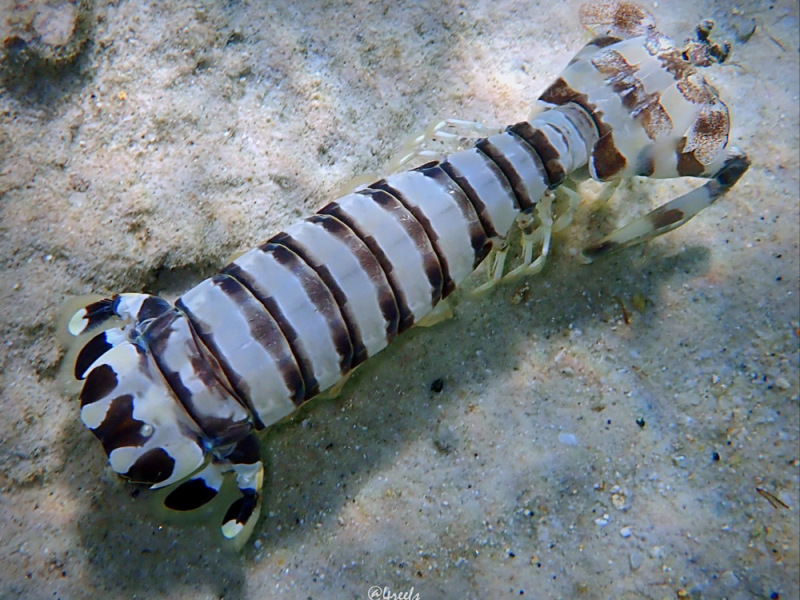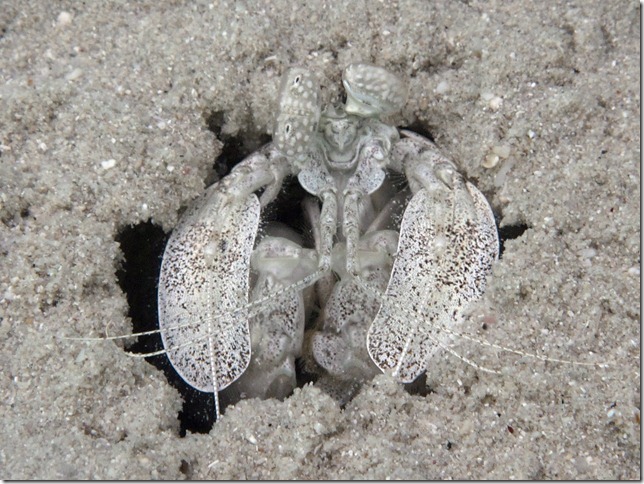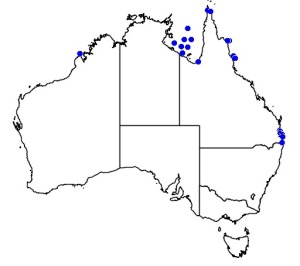�
�

©Damaris Torres-Pulliza: Lysiosquillina maculata, rarely seen outside its burrow, at Mangrove Beach, Lizard Island.

©Mark Shepherd: Lysiosquillina maculata at the entrance to its burrow in Watson's Bay, Lizard Island. Note white spots on the eyes.
�
���
Lysiosquillina maculata

©Damaris Torres-Pulliza: Lysiosquillina maculata, rarely seen outside its burrow, at Mangrove Beach, Lizard Island.

©Mark Shepherd: Lysiosquillina maculata at the entrance to its burrow in Watson's Bay, Lizard Island. Note white spots on the eyes.
Kingdom
Animalia
Phylum
Arthropoda
Class
Malacostraca
Order
Stomatopoda
Family
Lysiosquillidae
Genus
Lysiosquillina
Species
Lysiosquillina maculata
Colours
Distinguishing features
The largest stomatopod, reaching 40 cm in length. Lives in monogamous pairs in deep u-shaped burrows in shallow sandy areas. Pale with transverse bands. Comb-shaped spearing appendage with 10- 11 teeth used for catching fish. Bilobed eyes covered with white spots. (Roy's List accessed 10 Oct 2018, link below)
Size
- From 1.5 cm to 40 cm (Length according to Roy's List accessed 10 Oct 2018, link below.)
Synonyms
Similar taxa
-
Animalia:
species: Lysiosquillina sulcata
co-occurs with Lysiosquillina maculata at Lizard Island. It grows to a smaller size (15 cm vs up to 40 cm), does not have white spots on the eyes, and has uniformly-coloured antennal scales (Roy Caldwell, pers. com., 2018).
Distribution
Local abundance
- Lizard Island: This species is fairly common in shallow sandy areas all around the island. Their presence can be detected by their u-shaped burrows with entrances 4 to 5 cm in diameter and 1 to 1.5 metres apart, sometimes closed with a mucus/sand cap.
Web resources
References
- Blanco, M.M. and S.N. Patek (2014). Muscle trade-offs in a power-amplified prey capture system. Evolution, 68: 1399-1414. LIRS catalog number 1777.
- Feller, K.D. and T.W. Cronin (2016). Spectral absorption of visual pigments in stomatopod larval photoreceptors. Journal of Comparative Physiology A, 202: 215-223. LIRS catalog number 1997.
- Feller, K.D., J.H. Cohen and T.W. Cronin (2015). Seeing double: visual physiology of double-retina eye ontogeny in stomatopod crustaceans, Journal of Comparative Physiology A, 201: 331-339. LIRS catalog number 1876.
- View all references




